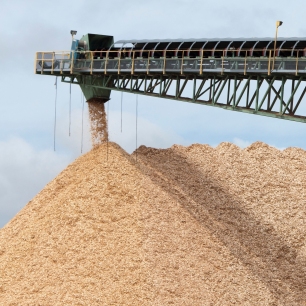
 Over the past several years, chip and pulpwood prices in the Pacific Northwest have demonstrated significant levels of volatility when compared to the relatively flat performance in the US South.
Over the past several years, chip and pulpwood prices in the Pacific Northwest have demonstrated significant levels of volatility when compared to the relatively flat performance in the US South.
March 3, 2021 - As global consumer trends and demands continue to shift at an escalating pace — especially given the events of 2020 — markets for wood fiber residuals have undergone both structural and temporal changes. A comprehensive Forest2Market report on this topic sought to understand the relationship between the supply and demand of wood residual materials over a 10-year period from 2007-2017.
The geographic scope for the study was divided into two broad regions of the United States: the US South and the Pacific Northwest (PNW). The study found that there are four underlying market forces that most impacted the residual market.
Over the past several years, chip and pulpwood prices in the PNW have demonstrated significant levels of volatility when compared to the relatively flat performance in the US South. More recently, and in the wake of the COVID-19 pandemic, prices for these products have plunged in the PNW as supply has risen while demand has tapered - even though the region remains resource-constrained.
Timber supplies in the PNW are stressed due to lack of management and harvesting on federal lands, and the region experienced devastating effects from seasonal wildfires in 2020. So much timber has been damaged, in fact, that crews will be cutting to salvage fire-killed timber for many months - even years. In particular, the Cascades region of Western Oregon that stretches over a vast area from California to the Columbia River suffered a great loss of resources. For example, in Lane County, Oregon, the 2018 annual harvest totaled 559 MMBF; fire losses on the county's private forests alone may amount to nearly one-year's total harvest.
Despite the devastating fires, lumber production in the PNW during 2H2020 was up roughly 5% from 1H2020; in BC, it was up about 16%. While lumber manufacturers ramped up production to take advantage of record prices for finished softwood lumber, pulp and paper production in the region has declined. This development in the market led to a decrease in chip demand while supply, particularly for residuals, has increased. This combination of factors has driven the price point down, which has also impacted the pulpwood market.
Although the PNW has a vibrant solid wood industry, the US South currently has more active mills producing larger volumes of lumber, and capacity increases and greenfield mill projects are likely in the near term. This steady supply of sawmill chips has kept prices lower in the South, where softwood sawtimber and pulpwood prices have also remained low.
The complete article with price graphs is posted on Forest2Market's website under "Resources / Market Watch Blog": www.forest2market.com/blog.
SOURCE: Forest2Market
Paper Industry Newsletter
Stay on top of paper industry news
from around the world with
PaperAge's free weekly newsletter.
Delivered every Thursday.
Sign up today!